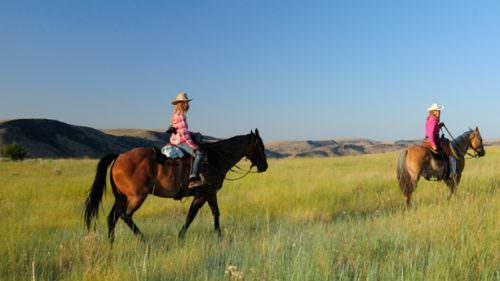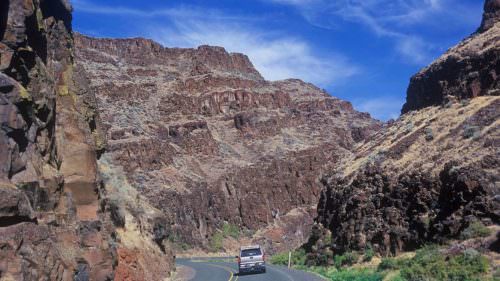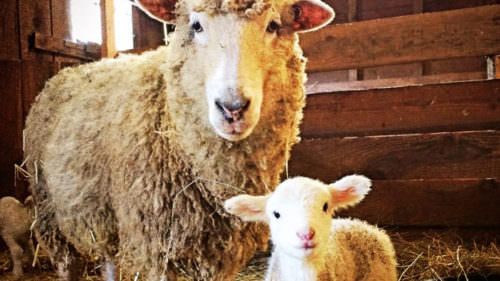An alarm goes off at 7:30 a.m. on my first day at Wilson Ranches Retreat. I’m admittedly not a morning person, but I make a good effort to leave my cocoon of blankets so that I can join everyone down at the breakfast table. The smell of sizzling bacon helps.
Located in Fossil, the Wilson Ranch has been around since 1962, but the roots and family history behind the place date back to the 1800s. Currently owned and operated by Phil Wilson, daughter Kara Wilson Anglin and her husband, Brian Anglin, the 9,000-acre property is a working cattle ranch with a bed-and-breakfast. There are six rooms to choose from, and family-style breakfast is served at the dining table every morning at 8 a.m., when you’ll get a chance to meet the other guests in the house and get to know Kara, a proud sixth-generation Oregonian, over a cup of coffee.
“So we hear you’re going to visit Antelope today?” Kara asks me with a surprised tone and a bit of a chuckle.
I explain that I’m venturing around Eastern and Central Oregon — curious about Antelope and the story of Rajneeshpuram after a Netflix binge of the 2018 Emmy Award-winning docu-series “Wild Wild Country.” For the uninitiated, the six episodes tell the story of Indian guru Bhagwan Shree Rajneesh and his followers, who attempted to build a utopia in rural Central Oregon. The long-gone Rajneeshpuram Ranch was located in the town of Antelope between 1981 and 1986 (at which point the Bhagwan was arrested and deported after brooding conflict and scandal erupted with the locals).
The series is both dramatically puzzling and intriguing, enough for one to want to travel to this region of state and explore a bit. And as it turns out, I’ve been one of many on this mission.



Small Town, Mini Museum
To reach Antelope, I leave Fossil and drive for about 35 miles along Oregon Route 218, one leg of the Journey Through Time Scenic Byway. As I near Antelope, I pass the entry point of the of the former Rajneeshpuram Ranch, which is now the Washington Family Ranch and Young Life Christian Camp. A wise tip to other docu-inspired road-trippers: You’ll want to avoid visiting this private property. There isn’t anything to see here. Plus, the road down is steep, unpaved and 20 miles long. Instead, head straight into Antelope, where the main attraction is at the corner of Maupin and Main streets.
Housed in the A.O.U.W. Hall (which was formerly the Rajneeshpuram office and printing plant), Antelope local and self-made historian Cody Flecker will welcome and invite you into his mini-museum where he showcases an arsenal of artifacts (books, signs, photos, clothing and newspaper clippings) from the Rajneeshpuram days. His collection is truly amazing, and he is a delight to meet and talk with.
“We’ve had people come from all over to see this,” Flecker tells me. He lists countries such as the Netherlands, Germany and South Africa, and remarks at the great distances people have traveled to come visit. “They’ve seen the show, and now they want to see the corroborating evidence.”
Flecker mans the A.O.U.W. Hall most days from noon to 5 p.m. on a donation basis, and although he won’t ask for it, you should take some cash to stuff into his donation box, as he is incredibly welcoming and generous to intrigued visitors like myself. Be sure to call ahead to make sure he’ll be open (928-301-9961).
After visiting with Flecker, I pass by the “Good Riddance mini-memorial” between Union and Maupin streets — essentially a plaque at the base of a flag pole that the Antelope townspeople erected here after the Rajneeshpuram Ranch had closed. You’ll recognize it from the final episode of the Netflix series, a small reminder of Antelope’s fascinating history.


Way More to See
Planning a trip to this part of Eastern Oregon just to see Antelope it is well worth it, though it’s a half-day excursion at most. I dedicate a few more days to understanding this arid side of the Cascades, which served as the setting for the “Wild Wild Country” saga. The region is rich in history (hello, prehistoric fossil beds) and also offers incredible opportunities to soak up the high-desert sunshine, something that newcomers might not believe exists here in Oregon.
Curious travelers planning a getaway to this wild pocket of the Pacific Northwest should pack boots and hats — you’ll need both out here in cowboy country. That’s something I noticed from the moment I hit the road.
Here’s how to retrace my itinerary, starting in Portland, heading to the Wilson Ranch (my homebase for the trip) and ending with the visit to Antelope: My adventure truly began with the landscape transforming from lush forests to golden plateau as I drove out of Portland, through the Columbia River Gorge and past The Dalles. As I journeyed down Highway 206 toward Fossil, I passed through Wasco and miles of very Instagram-worthy wind-turbine fields. Along the way, I stopped at Cottonwood Canyon State Park, Oregon’s newest state park located on the John Day River. There are a few trails through sagebrush-covered landscapes for hiking or mountain biking. Did I mention loaner mountain bikes are free for guests to ride around the park?
After a quick pedal around the park, I headed into Condon for a late lunch and a cold beer at The Round-Up, where the nightly food specials are recommended by the locals. There is also a teeny-tiny Powell’s Books Annex located in Country Flowers next door, in case you want to pick up some reading material for the weekend.

From Condon, it’s fewer than 20 miles to Fossil, where the Wilson Ranches Retreat is located. Be sure to check out Main Street in town, where you can pick up some local steaks at Fossil Mercantile Company, or a pizza at Sally Foods next door. Plan ahead — this could very well be your dinner back at the ranch later.
There’s plenty to do a short drive from the ranch. For daytime excursions in and out of Fossil, ask the Wilson-Anglins at breakfast and they’ll guide you. Captivating any time of the year, the Thomas Condon Paleontology Center displays some 500 fossils and introduces the significance of the John Day Fossil Beds National Monument. When the weather is warm, an easy daytime adventure loop is driving from Fossil down toward Service Creek and Spray, where you can get outfitted with a life jacket and then spend the rest of the day swimming, rafting, kayaking or stand-up paddleboarding on the John Day River. From Spray, Highway 19 will then take you down into Mitchell, another Eastern Oregon activity hub. From there you can travel the Journey Through Time Scenic Byway and back into Fossil.
And the ranch ranks as a destination unto itself. Guests usually take off for adventures during the day and return to the ranch for a horseback ride, watching as the light wanes and the setting sun sets the sky on fire.


Back-Porch Moments
My weekend spent exploring the history of “Wild Wild Country” firsthand certainly fulfilled my curiosity. It also taught me a thing or two about how this part of the state — and this family, in particular — defines country life.
Evening horseback rides into the sunset, local steak and cold beer, hillsides of sage and juniper, and sitting on the back porch in the light of a full moon — all of these things are part of life at the Wilson ranch and Eastern Oregon.
Upon returning to Portland, I remember something Kara said to me and how perfectly it described my experience: “I like ‘profound.’ That’s my word … ‘profound,’” she says. “I like the ahhhhmoments.”
Well, she has succeeded, because Wilson Ranches Retreat and this corner of Oregon are full of them.
If You Go:
- In this part of the state, businesses and attractions may keep irregular hours or close seasonally. Call ahead to ensure your chosen destinations will be open and to make advance lodging reservations.
- Check your route for road closures and current conditions on TripCheck.com, especially in winter when the weather can change in a minute in Central and Eastern Oregon.
- Always aim to leave no trace: Tread lightly wherever you go. When in natural recreation areas, carry out whatever you bring in with you — your help is needed to keep these areas available to enjoy! Be respectful of the locals and don’t trespass on private property. Even if a property looks abandoned, that doesn’t mean it is.
- While wildfires don’t often cause major travel disruptions, this part of the state is susceptible. It’s good to know how they may impact your trip; find answers to frequently asked questions here. Keep in mind that you can help prevent human-caused wildfires.
- Carry a paper highway map and don’t rely on your GPS, as cell reception can be spotty in these parts.
- Fill up your gas tank whenever you get a chance. Service stations on these remote roads are few and far between.



